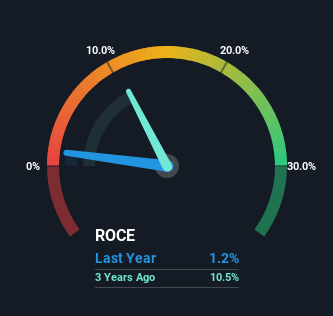Stock Analysis
- United States
- /
- Semiconductors
- /
- NasdaqGS:FORM
FormFactor (NASDAQ:FORM) Will Be Hoping To Turn Its Returns On Capital Around

To find a multi-bagger stock, what are the underlying trends we should look for in a business? Firstly, we'd want to identify a growing return on capital employed (ROCE) and then alongside that, an ever-increasing base of capital employed. Put simply, these types of businesses are compounding machines, meaning they are continually reinvesting their earnings at ever-higher rates of return. However, after briefly looking over the numbers, we don't think FormFactor (NASDAQ:FORM) has the makings of a multi-bagger going forward, but let's have a look at why that may be.
What Is Return On Capital Employed (ROCE)?
For those that aren't sure what ROCE is, it measures the amount of pre-tax profits a company can generate from the capital employed in its business. To calculate this metric for FormFactor, this is the formula:
Return on Capital Employed = Earnings Before Interest and Tax (EBIT) ÷ (Total Assets - Current Liabilities)
0.012 = US$12m ÷ (US$1.1b - US$131m) (Based on the trailing twelve months to December 2023).
So, FormFactor has an ROCE of 1.2%. In absolute terms, that's a low return and it also under-performs the Semiconductor industry average of 9.7%.
Check out our latest analysis for FormFactor

In the above chart we have measured FormFactor's prior ROCE against its prior performance, but the future is arguably more important. If you're interested, you can view the analysts predictions in our free analyst report for FormFactor .
How Are Returns Trending?
In terms of FormFactor's historical ROCE movements, the trend isn't fantastic. Over the last five years, returns on capital have decreased to 1.2% from 5.8% five years ago. Given the business is employing more capital while revenue has slipped, this is a bit concerning. This could mean that the business is losing its competitive advantage or market share, because while more money is being put into ventures, it's actually producing a lower return - "less bang for their buck" per se.
Our Take On FormFactor's ROCE
From the above analysis, we find it rather worrisome that returns on capital and sales for FormFactor have fallen, meanwhile the business is employing more capital than it was five years ago. Yet despite these poor fundamentals, the stock has gained a huge 157% over the last five years, so investors appear very optimistic. In any case, the current underlying trends don't bode well for long term performance so unless they reverse, we'd start looking elsewhere.
Like most companies, FormFactor does come with some risks, and we've found 2 warning signs that you should be aware of.
If you want to search for solid companies with great earnings, check out this free list of companies with good balance sheets and impressive returns on equity.
Valuation is complex, but we're helping make it simple.
Find out whether FormFactor is potentially over or undervalued by checking out our comprehensive analysis, which includes fair value estimates, risks and warnings, dividends, insider transactions and financial health.
View the Free AnalysisHave feedback on this article? Concerned about the content? Get in touch with us directly. Alternatively, email editorial-team (at) simplywallst.com.
This article by Simply Wall St is general in nature. We provide commentary based on historical data and analyst forecasts only using an unbiased methodology and our articles are not intended to be financial advice. It does not constitute a recommendation to buy or sell any stock, and does not take account of your objectives, or your financial situation. We aim to bring you long-term focused analysis driven by fundamental data. Note that our analysis may not factor in the latest price-sensitive company announcements or qualitative material. Simply Wall St has no position in any stocks mentioned.
About NasdaqGS:FORM
FormFactor
Designs, manufactures, and sells probe cards, analytical probes, probe stations, metrology systems, thermal systems, and cryogenic systems to semiconductor companies and scientific institutions.
Flawless balance sheet with acceptable track record.

